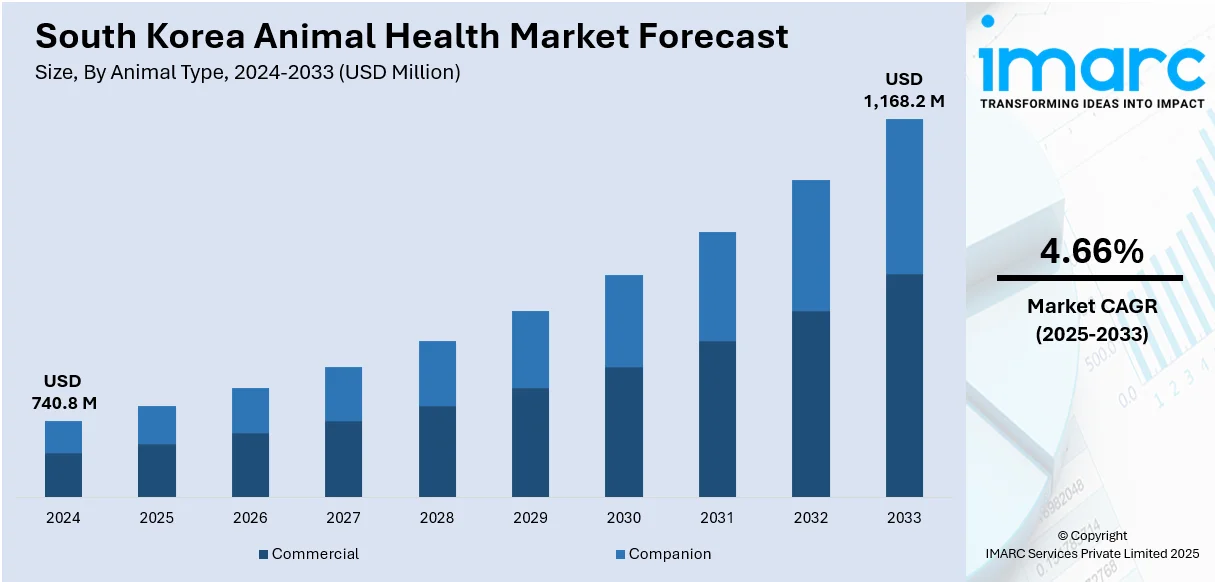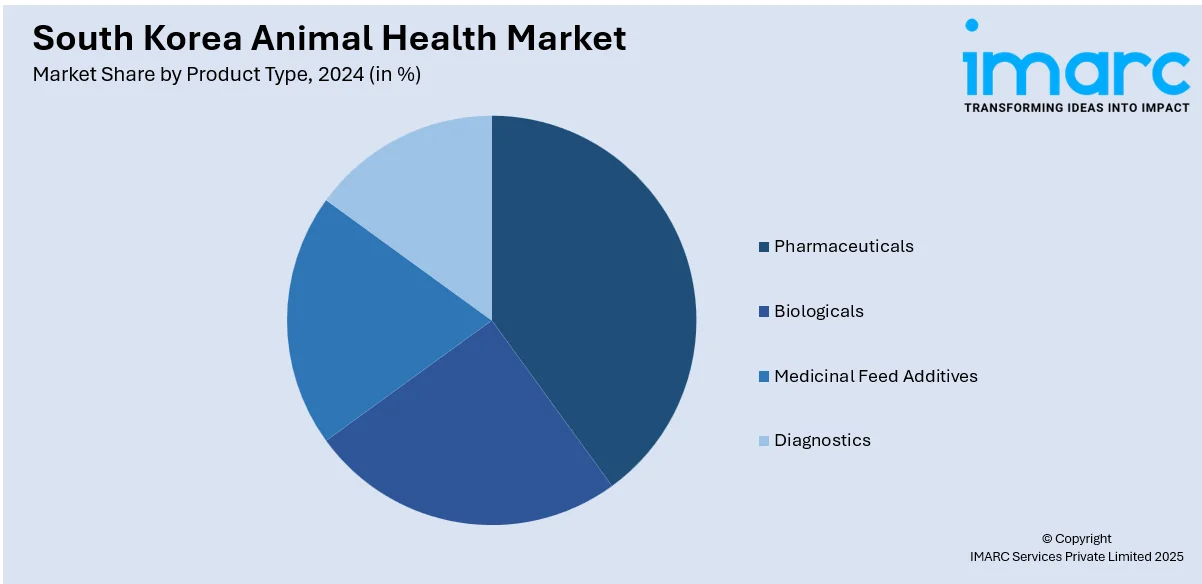
South Korea Animal Health Market Size, Share, Trends and Forecast by Animal Type, Product Type, and Region, 2025-2033
South Korea Animal Health Market Overview:
The South Korea animal health market size reached USD 740.8 Million in 2024. Looking forward, IMARC Group expects the market to reach USD 1,168.2 Million by 2033, exhibiting a growth rate (CAGR) of 4.66% during 2025-2033. At present, the demand for meat, dairy, and other livestock products is growing steadily in South Korea, propelling the market growth. Moreover, pet adoption is rising in the country, reconfiguring the market by generating demand for companion animal care services and products. Apart from this, the heightened implementation of inclusive policies, financing, and regulatory developments designed to improve veterinary infrastructure is expanding the South Korea animal health market share.
|
Report Attribute
|
Key Statistics
|
|---|---|
|
Base Year
|
2024
|
|
Forecast Years
|
2025-2033
|
|
Historical Years
|
2019-2024
|
| Market Size in 2024 | USD 740.8 Million |
| Market Forecast in 2033 | USD 1,168.2 Million |
| Market Growth Rate 2025-2033 | 4.66% |
South Korea Animal Health Market Trends:
Growing Demand for Livestock Products
Demand for meat, dairy, and other livestock products is growing steadily in South Korea, propelling the market growth. Since people are becoming increasingly health-conscious and looking for high-quality animal food, farmers are working to improve livestock productivity and health. This demand is encouraging producers to implement enhanced veterinary practices such as routine vaccinations, disease testing, and nutritional management. In addition, the government's initiative for encouraging food safety standards is getting livestock owners to invest in preventive healthcare. With the diet of the population still moving towards increased protein intake, livestock producers are reacting by enhancing animal welfare and health performance. These trends are converting into long-term veterinary pharma sales growth, diagnostics, and feed additives. The ongoing drive for quality and productivity in the animal husbandry industry is positioning animal health as a critical component of agricultural activity. The IMARC Group predicts that the South Korea meat market is anticipated to reach USD 49.0 Billion by 2033.

To get more information on this market, Request Sample
Growing Pet Adoption and Companion Animal Care
Pet adoption is rising in South Korea, generating increasing demand for companion animal care services and products, thereby supporting the South Korea animal health market growth. Urbanization, declining family sizes, and new lifestyles are persuading more families and individuals to keep pets, especially dogs and cats. Such a shift in culture is bringing pets into the family fold, and hence, more focus on their health. Pet parents are specifically looking for preventive healthcare services like regular check-ups, immunizations, and parasite management. Also, fueling veterinary industry growth are the expansion of pet insurance, specialty pet clinics, and high-quality pet food. Furthermore, health awareness programs for pets and online sites are enhancing access to veterinary information, enabling proactive care. As companion animals become a part of everyday life in South Korea, there is a consistent demand for sophisticated veterinary services and pharmaceutical products, thereby driving the market and fostering innovation in pet-centric healthcare solutions. As of December last year, over 15 million individuals in Korea had pets, representing almost 30 percent of the country's total population, as stated in a report published by KB Financial Group.
Government Support and Regulatory Improvements
The government of South Korea is actively promoting the animal health industry through inclusive policies, financing, and regulatory developments designed to improve veterinary infrastructure and biosecurity. Governments are putting in place more robust disease surveillance systems, particularly to address outbreaks like foot-and-mouth disease (FMD) and avian influenza that have caused livestock health and trade problems over time. By investing in research, diagnostics, and early response infrastructure, the government is supporting the growth of robust animal health systems. New regulations are making it easier to approve veterinary medicines and vaccines, enabling faster market entry for breakthrough solutions. In addition, public-private collaborations are encouraged to enhance rural veterinary services and promote access to animal healthcare. The government also encourages educational initiatives to enhance the number of qualified veterinarians. These constant regulatory improvements and institutional support mechanisms are establishing a stronger and more transparent animal health environment, which is contributing to the growth of the sector in South Korea. In 2025, South Korea established an ambitious goal to grow its animal medicine sector, targeting a total market worth of $2.7 billion by 2035. The nation aims to reach this expansion by enhancing its research and development initiatives in veterinary medicine, boosting exports, and elevating the overall quality of animal health products.
South Korea Animal Health Market Segmentation:
IMARC Group provides an analysis of the key trends in each segment of the market, along with forecasts at the country and regional levels for 2025-2033. Our report has categorized the market based on animal type and product type.
Animal Type Insights:
- Commercial
- Companion
The report has provided a detailed breakup and analysis of the market based on the animal type. This includes commercial and companion.
Product Type Insights:

- Pharmaceuticals
- Biologicals
- Medicinal Feed Additives
- Diagnostics
A detailed breakup and analysis of the market based on the product type have also been provided in the report. This includes pharmaceuticals, biologicals, medicinal feed additives, and diagnostics.
Regional Insights:
- Seoul Capital Area
- Yeongnam (Southeastern Region)
- Honam (Southwestern Region)
- Hoseo (Central Region)
- Others
The report has also provided a comprehensive analysis of all the major regional markets, which include Seoul Capital Area, Yeongnam (Southeastern Region), Honam (Southwestern Region), Hoseo (Central Region), and others.
Competitive Landscape:
The market research report has also provided a comprehensive analysis of the competitive landscape. Competitive analysis such as market structure, key player positioning, top winning strategies, competitive dashboard, and company evaluation quadrant has been covered in the report. Also, detailed profiles of all major companies have been provided.
South Korea Animal Health Market Report Coverage:
| Report Features | Details |
|---|---|
| Base Year of the Analysis | 2024 |
| Historical Period | 2019-2024 |
| Forecast Period | 2025-2033 |
| Units | Million USD |
| Scope of the Report |
Exploration of Historical Trends and Market Outlook, Industry Catalysts and Challenges, Segment-Wise Historical and Future Market Assessment:
|
| Animal Types Covered | Commercial, Companion |
| Product Types Covered | Pharmaceuticals, Biologicals, Medicinal Feed Additives, Diagnostics |
| Regions Covered | Seoul Capital Area, Yeongnam (Southeastern Region), Honam (Southwestern Region), Hoseo (Central Region), Others |
| Customization Scope | 10% Free Customization |
| Post-Sale Analyst Support | 10-12 Weeks |
| Delivery Format | PDF and Excel through Email (We can also provide the editable version of the report in PPT/Word format on special request) |
Key Questions Answered in This Report:
- How has the South Korea animal health market performed so far and how will it perform in the coming years?
- What is the breakup of the South Korea animal health market on the basis of animal type?
- What is the breakup of the South Korea animal health market on the basis of product type?
- What is the breakup of the South Korea animal health market on the basis of region?
- What are the various stages in the value chain of the South Korea animal health market?
- What are the key driving factors and challenges in the South Korea animal health market?
- What is the structure of the South Korea animal health market and who are the key players?
- What is the degree of competition in the South Korea animal health market?
Key Benefits for Stakeholders:
- IMARC’s industry report offers a comprehensive quantitative analysis of various market segments, historical and current market trends, market forecasts, and dynamics of the South Korea animal health market from 2019-2033.
- The research report provides the latest information on the market drivers, challenges, and opportunities in the South Korea animal health market.
- Porter's five forces analysis assist stakeholders in assessing the impact of new entrants, competitive rivalry, supplier power, buyer power, and the threat of substitution. It helps stakeholders to analyze the level of competition within the South Korea animal health industry and its attractiveness.
- Competitive landscape allows stakeholders to understand their competitive environment and provides an insight into the current positions of key players in the market.
Need more help?
- Speak to our experienced analysts for insights on the current market scenarios.
- Include additional segments and countries to customize the report as per your requirement.
- Gain an unparalleled competitive advantage in your domain by understanding how to utilize the report and positively impacting your operations and revenue.
- For further assistance, please connect with our analysts.
 Request Customization
Request Customization
 Speak to an Analyst
Speak to an Analyst
 Request Brochure
Request Brochure
 Inquire Before Buying
Inquire Before Buying




.webp)




.webp)












